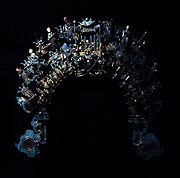
Kingfisher feather art: tian-tsui
Encyclopedia

Kingfisher
Kingfishers are a group of small to medium sized brightly coloured birds in the order Coraciiformes. They have a cosmopolitan distribution, with most species being found in the Old World and Australia...
birds as an inlay for fine art objects and adornment, from hairpins, headdresses, and fans to even panels and screens. While Western art collectors have focused on other areas of Chinese art including porcelain
Porcelain
Porcelain is a ceramic material made by heating raw materials, generally including clay in the form of kaolin, in a kiln to temperatures between and...
, lacquer
Lacquer
In a general sense, lacquer is a somewhat imprecise term for a clear or coloured varnish that dries by solvent evaporation and often a curing process as well that produces a hard, durable finish, in any sheen level from ultra matte to high gloss and that can be further polished as required...
ware, sculpture, cloisonné
Cloisonné
Cloisonné is an ancient technique for decorating metalwork objects, in recent centuries using vitreous enamel, and in older periods also inlays of cut gemstones, glass, and other materials. The resulting objects can also be called cloisonné...
, silk
Silk
Silk is a natural protein fiber, some forms of which can be woven into textiles. The best-known type of silk is obtained from the cocoons of the larvae of the mulberry silkworm Bombyx mori reared in captivity...
and paintings, kingfisher art is relatively unknown outside of China
China
Chinese civilization may refer to:* China for more general discussion of the country.* Chinese culture* Greater China, the transnational community of ethnic Chinese.* History of China* Sinosphere, the area historically affected by Chinese culture...
.
Called tian-tsui (点翠, “dotting with kingfishers”), kingfisher feathers are painstakingly cut and glued onto gilt silver. The effect is like cloisonné, but no enamel was able to rival the electric blue color. Blue is the traditional favorite color in China.
As with most iridescent, electrifying colors in animals such as Morpho butterfly wings, the intense color in bird feathers comes not from pigments in the feather itself, but from the way light is bent and reflected back out, much like a prism breaks white light into its spectrum of rainbow colors. These microscopic structures in feathers are called photonic crystals.
The most expensive, commissioned pieces used a species of kingfisher from Cambodia
Cambodia
Cambodia , officially known as the Kingdom of Cambodia, is a country located in the southern portion of the Indochina Peninsula in Southeast Asia...
. So great was the export to sate Chinese demand, the trade of feathers may have been a major contributor to the wealth of the Khmer Empire
Khmer Empire
The Khmer Empire was one of the most powerful empires in Southeast Asia. The empire, which grew out of the former kingdom of Chenla, at times ruled over and/or vassalized parts of modern-day Laos, Thailand, Vietnam, Burma, and Malaysia. Its greatest legacy is Angkor, the site of the capital city...
, and used to help fund the construction of the magnificent temples near Siem Reap
Siem Reap
Siem Reap is the capital city of Siem Reap Province in northwestern Cambodia, and is the gateway to Angkor region.Siem Reap has colonial and Chinese-style architecture in the Old French Quarter, and around the Old Market...
, Cambodia including Angkor Wat
Angkor Wat
Angkor Wat is a temple complex at Angkor, Cambodia, built for the king Suryavarman II in the early 12th century as his state temple and capital city. As the best-preserved temple at the site, it is the only one to have remained a significant religious centre since its foundation – first Hindu,...
. The finest pieces of kingfisher art were reserved for royalty or high-ranking Chinese government official (called a "mandarin (bureaucrat)
Mandarin (bureaucrat)
A mandarin was a bureaucrat in imperial China, and also in the monarchist days of Vietnam where the system of Imperial examinations and scholar-bureaucrats was adopted under Chinese influence.-History and use of the term:...
"). Sadly, the usage of kingfisher feathers resulted in the mass slaughter of many kingfisher species.
Kingfisher art as a high art form came to an end during the Chinese revolution in the 1940’s.

